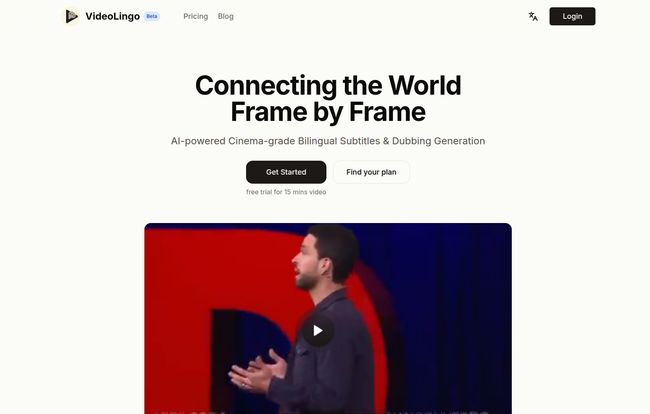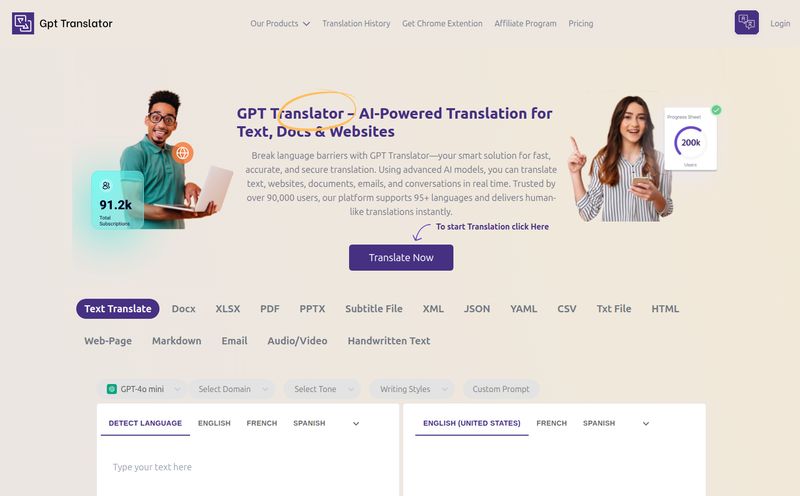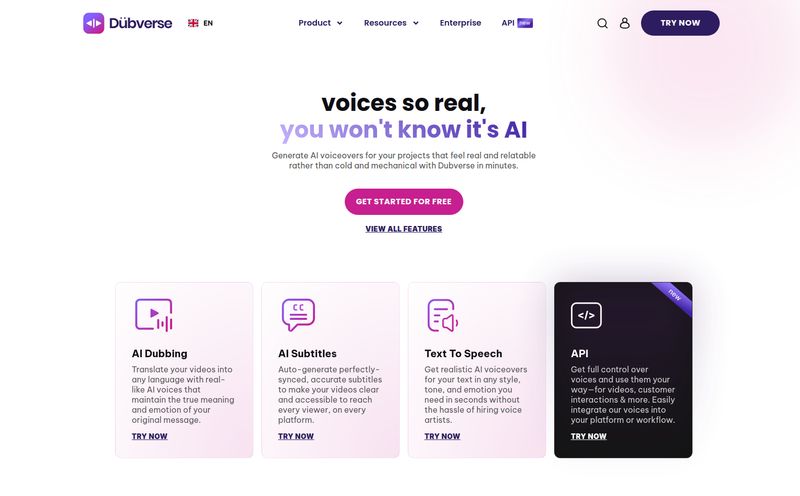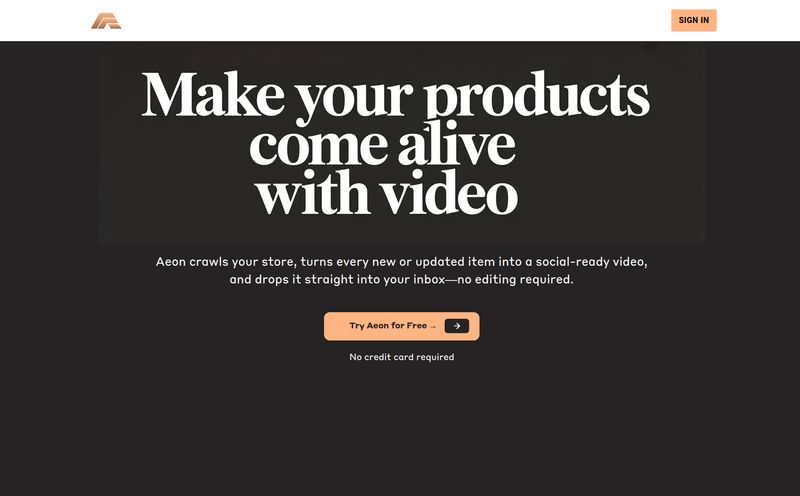I’ve been in this SEO and traffic game for a long time. I’ve seen fads come and go, from keyword stuffing back in the day (yikes) to the current obsession with AI-everything. And look, I get it. The promise of reaching a global audience without hiring a team of translators and voice actors is… well, it’s the dream, isn't it?
For years, making your video content truly international meant one of two things: a massive budget or slapping on some clunky, auto-generated captions that often did more harm than good. We've all seen those YouTube caption fails that turn a serious tutorial into an accidental comedy sketch. But the landscape is shifting. Fast. I've been keeping a close eye on a new crop of AI localization tools, and one that recently popped up on my radar is VideoLingo. Their tagline is bold: “Connecting the World Frame by Frame.” Okay, nice. But as we all know, marketing is one thing. Reality is another. So, I decided to take a look under the hood.
So, What is VideoLingo, Really?
At its core, VideoLingo is an AI tool designed to take your video and automatically generate both subtitles and dubbed audio for different languages. The homepage talks a big game, promising “Netflix-quality” and “cinema-grade” results. That’s a high bar. A very high bar.
But what caught my eye wasn't just the promise of quality, but the type of quality they're aiming for. They break it down into a few key areas that show they're thinking beyond just literal, word-for-word translation.
- Cultural Localization: This is huge. It’s about translating idioms and cultural nuances, not just words. Think of it as the difference between a tourist with a phrasebook and a local guide who knows the slang.
- Domain Expertise: The tool claims to handle field-specific terminology. This is critical for anyone in tech, medicine, or finance. Translating a coding tutorial requires a different vocabulary than a travel vlog.
- Enhanced Readability: For subtitles, this means proper timing and segmentation. Nothing worse than a giant block of text that covers the whole screen and disappears before you can read it.
- Natural Voice Synthesis: This is the holy grail for AI dubbing. Avoiding that robotic, monotone voice that screams “I am a machine.”
Essentially, VideoLingo isn't just a dictionary. It’s trying to be a cultural interpreter and a voice actor all in one. A pretty ambitious goal for a piece of software.

Visit VideoLingo
The Features That Actually Matter to Creators
Alright, let's cut through the jargon. If you’re a creator or a business, what does this actually mean for your workflow and your audience? I’ve managed content teams, and I know where the real pain points are.
Subtitles That Don’t Make You Cringe
Let's be honest, the first step for most people into localization is subtitles. They improve accessibility and SEO, since search engines can crawl the text. VideoLingo’s promise of “Enhanced Readability” and “Domain Expertise” is music to my ears. I've spent countless hours manually correcting the timing and wording of auto-generated captions. If this tool can deliver subtitles that are 90-95% accurate and well-timed right out of the box, that’s not just a time-saver; it’s a game-changer. It frees you up to focus on the content itself, not the tedious post-production busywork.
AI Dubbing: The Final Frontier?
Dubbing has always been the expensive, difficult older sibling of subtitles. Bad dubbing is incredibly jarring and can completely ruin the viewing experience. This is where AI has the most to prove. VideoLingo talks about “Natural Voice Synthesis,” which aims to capture the right emotional tone and speaking style. This is where I'm cautiously optimistic. Early AI voices were... rough. But the tech is improving at a scary pace.
What’s really interesting is the “Pro” plan feature: Clone dubbing mode. The idea of dubbing a video into Spanish or Chinese in my own voice is wild. If they can pull that off convincingly, it will be a massive step toward creating a more personal connection with international audiences. It’s one thing to hear a generic voiceover; it’s another to hear the original creator’s voice, just speaking a different language.
Let's Talk Money: The VideoLingo Pricing Plans
Okay, this is often the make-or-break moment. Is this tool accessible to a solo creator, or is it enterprise-only? I was pleasantly surprised to see a clear, tiered pricing structure.
| Plan | Price | Key Features | My Take |
|---|---|---|---|
| FREE | $0 /mo | 15 mins of video, English/Chinese only, 480p output, watermark, no dubbing. | Perfect for testing the waters. You can see how the subtitle generation works on a short clip before commiting. Don't expect to run your channel on this. |
| STARTER | $5 /mo | 1 hour of video, 8 languages, 1080p output, basic dubbing. | This is the sweet spot for most content creators. An hour of video processing for five bucks is incredibly competitive. This is enough for a few videos a month. |
| PRO | $30 /mo | 6 hours of video, clone dubbing, voice separation, upcoming OpenAI access. | For agencies, businesses, or power-creator who produce a lot of content. The clone dubbing and extra hours are the main draw here. Serious value for serious users. |
The pricing feels very grounded in reality. The free tier is genuinely useful for a trial run, and the Starter plan at $5 is almost a no-brainer for anyone who's even thinking about multilingual content. It lowers the barrier to entry significantly.
The AI Engine vs. The Human Touch
Now for a dose of reality. No AI tool is a magic wand. At least, not yet. The biggest mistake I see people make with AI is treating it as a one-click solution that requires zero oversight. That’s a recipe for disaster.
"AI should be your most talented intern, not your CEO. It does the heavy lifting, but you still need to do the final review."
Even with the best cultural localization and domain expertise, there will be nuances it misses. A joke that doesn't land right, an idiom that has a slightly wrong connotation. I would never take the output from VideoLingo, or any similar tool like HeyGen or Rask.ai, and publish it blind. The real workflow here is using the AI to get you 95% of the way there in minutes, instead of the hours or days it would take to do it manually. Your job is that final 5% polish. Review the subtitles. Listen to the dub. Make sure it truly represents your brand and message. This isn't a flaw in VideoLingo; its a best practice for working with AI in 2024.
Final Verdict: Is VideoLingo a Contender?
So, is VideoLingo the real deal? From what I've seen, it's a very strong contender. It's not just another soulless translation engine. The focus on cultural nuance, readability, and natural-sounding audio shows they understand the art of localization, not just the science.
The pricing is aggressive and makes it accessible to just about everyone. For solo creators, the Starter plan is a fantastic entry point to test global waters. For businesses, the Pro plan offers features that, just a few years ago, would have cost thousands of dollars per video.
My advice? Don't just take my word for it. Sign up for the free plan. Grab one of your most popular videos—maybe a 5-10 minute one—and run it through the system. See how the subtitles look. You have nothing to loose and a potential global audience to gain. The future of content is borderless, and tools like VideoLingo are building the bridges to get us there.
Frequently Asked Questions
Do the monthly credits expire?
Based on typical SaaS models for this kind of service, monthly credits usually reset at the beginning of each billing cycle. They generally don't roll over, so the idea is to choose a plan that closely matches your monthly production volume. For example, the 1-hour credit in the Starter plan is for that month's use.
What makes VideoLingo different from HeyGen or Rask.ai?
This is a great question. While all three are in the AI video space, they have slightly different focuses. HeyGen is very well known for its AI avatars and video generation, with localization being one of its features. Rask.ai is a direct competitor focused heavily on translation and dubbing. VideoLingo appears to be positioning itself with a strong emphasis on the quality and nuance of the localization, with features like “Cultural Localization” and “Domain Expertise” being front and center. Its competitive pricing, especially the $5 starter tier, also makes it very approachable.
Can I change or cancel my plan at any time?
Yes, like most modern subscription services, you can typically manage your plan from your account dashboard. You should be able to upgrade, downgrade, or cancel your subscription, with changes usually taking effect at the end of your current billing period. So if you cancel, you'd retain access until the month you paid for is over.
Which translation models are used?
The site doesn't specify the exact underlying models, which is common. However, they do mention that the upcoming Pro plan will feature “open API access (coming soon),” which hints at integrations with powerful models like those from OpenAI. It's likely they use a sophisticated blend of leading AI translation and voice synthesis technologies to achieve their results.
Is there a refund policy?
Most SaaS companies offer a refund policy, but the specifics can vary. It's often contingent on usage or if the service didn't work as advertised. Given they offer a very functional free tier, the company likely encourages users to test the service thoroughly before subscribing to ensure it meets their needs. It is always best to check their terms of service or contact support for the specific details.
Reference and Sources
- VideoLingo Official Website
- VideoLingo Pricing Page
- Forbes - The Role Of AI In Breaking Down Language Barriers (for further reading on the topic)



